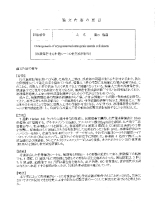Osteogenesis of cryopreserved osteogenic matrix cell sheets 冷凍保存骨芽細胞シートの骨形成能評価
この論文にアクセスする
著者
書誌事項
- タイトル
-
Osteogenesis of cryopreserved osteogenic matrix cell sheets
- タイトル別名
-
冷凍保存骨芽細胞シートの骨形成能評価
- 著者名
-
Shimizu, Takamasa
- 著者名
-
Akahane, Manabu
- 著者名
-
Ueha, Tomoyuki
- 著者名
-
Kido, Akira
- 著者名
-
Omokawa, Shohei
- 著者名
-
Kobata, Yasunori
- 著者名
-
Murata, Keiichi
- 著者名
-
Kawate, Kenji
- 著者名
-
Tanaka, Yasuhito
- 学位授与大学
-
奈良県立医科大学
- 取得学位
-
博士(医学)
- 学位授与番号
-
甲第607号
- 学位授与年月日
-
2013-11-27
注記・抄録
Cryopreservation of tissue engineered bone (TEB), whilst maintaining its osteogenic ability, is imperative for large-scale clinical application. We previously reported a novel cell transplantation method, in which bone-marrow-derived mesenchymal stem cells (BMSCs) were cultured to confluence and differentiated down the osteogenic lineage to form osteogenic matrix cell sheets (OMCS). OMCS have high alkaline phosphatase (ALP) activity and osteocalcin (OC) contents and can be easily used for producing TEB. The aim of the present study was to investigate whether TEB produced by cryopreserved OMCS maintains sufficient osteogenic potential in vivo. OMCS were prepared and divided into three groups according to storage period of cryopreservation (fresh (no cryopreservation), 4 week and 12 week cryopreservation groups). OMCS were cryopreserved by storage in freezing medium (Cell Banker 1®) at -80 °C. Cryopreserved OMCSs were rapidly thawed at room temperature and wrapped around Hydroxyapatite (HA) scaffolds prior to implantation into subcutaneous sites in rats, to determine their in vivo bone-forming capability. The constructs were harvested 4 weeks after transplantation and examined histologically and biochemically. Histological analysis of the constructs showed extensive bone formation in the HA pores with high ALP activity and OC content detected in the cryopreservation groups. The present study clearly indicates that cryopreserved/thawed OMCS are still capable of producing mineralized matrix on scaffolds, resulting in bone formation. This cryopreservation technique could be applied for hard tissue reconstruction to ease the cell preparation method prior to time of use.
博士(医学)・甲第607号・平成25年11月27日
identifier:Cryobiology Vol.66 No.3 p.326-332
identifier:00112240
identifier:http://ginmu.naramed-u.ac.jp/dspace/handle/10564/2672
identifier:Cryobiology, 66(3): 326-332
開始ページ : 326
終了ページ : 332
